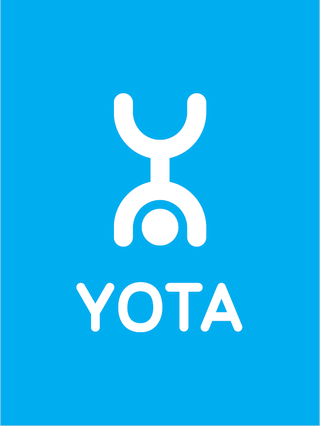Yota
Russian mobile virtual network operator From Wikipedia, the free encyclopedia
Yota[9] (Russian: Йота) is a Russian mobile virtual network operator.
This article has multiple issues. Please help improve it or discuss these issues on the talk page. (Learn how and when to remove these messages)
|
 | |
| Company type | Limited company |
|---|---|
| Industry | Telecommunications, consumer electronics, digital distribution |
| Founded | 2007 (SLL Scartel)[1] 2008 (ИОО Yota Бел)[2] |
| Defunct | 2019 |
| Fate | Bankruptcy |
Area served | Moscow, Saint Petersburg, Astrahan, Kazan, Khabarovsk, Kovrov, Kostroma, Krasnodar, Krasnoyarsk, Murom, Naberezhnye Chelny, Novosibirsk, Obninsk, Orenburg, Samara, Sochi, Tomsk, Tula, Ufa, Vladivostok, Vladimir, Yoshkar-Ola[3] |
Key people | Igor Torgov (CEO) |
| Services | Mobile internet, cell phone operator |
| Revenue | $486.78 million[4] (2017) |
| $116.55 million[4] (2017) | |
| Owner | MegaFon |
| Subsidiaries | SLL Scartel (Синамакс and Макмис owned by Scartel[5]) Scartel Starlab [6] More[6] ИОО Yota Бел (100%[7]) Yota de Nicaragua (75%[8]) |
Formerly, Yota was a Russian mobile phone brand and mobile broadband manufacturer.[10] Yota was a trademark of Skartel LLC. Yota later suffered bankruptcy due to a lawsuit.
Garsdale Services Investment Ltd. owned 100% of Yota's shares and 50% of MegaFon's shares. In turn, Garsdale is controlled by AF-Telecom (82%), Telconet Capital (13.5%), and the Russian Technologies State Corporation (4.5%).
History
In 2006, the co-owners of the St. Petersburg company Korus, Denis Sverdlov, and Bulgarian businessman Sergey Adonev established a provider of WiMAX. In 2008, Skartel was the first company in Russia to deploy WiMAX standard networks in Moscow and Saint Petersburg in a range of 2.5–2.7 GHz.
In 2010, Yota announced its plans to launch LTE on its network. The first test of the new standard network took place in Kazan on 30 August 2010. The subscribers gained access to the Internet at a rate of 20–30 Mbit/s. About 150 base stations have been installed in Kazan. The investments into the LTE network deployment constituted $20 million. The fourth generation LTE network, which was tested by the Yota provider in Kazan, was switched off the next day.
On May 9, 2012, Yota's WiMAX was replaced by its LTE network. In September 2012, 4G networks were launched in the Russian cities of Novosibirsk, Krasnodar, Sochi, Samara, Vladivostok, Ufa, Kazan, Moscow, and Saint Petersburg.
In April 2019, Yota filed for bankruptcy. The bankruptcy stemmed from a lawsuit filed against the company by its contracted manufacturer, Hi-P Singapore.[11][12]
Long-term evolution
Officially, Novosibirsk was the first Russian city where the LTE network was deployed, commercially launched on 22 December 2011. Then, it was adopted in Krasnodar (29 April 2012), Moscow (10 May 2012), and Sochi (11 May 2012). Samara was connected to LTE on 23 May 2013. And later on, Ufa and Saint Petersburg have also joined this service.
LTE networks work within a range of 2.5–2.7 GHz, which is one of the ranges accepted as standard by the International Telecommunication Union. In Russia, these frequencies have also been selected by the Ministry of Communications and Mass Communications of the Russian Federation for the 4th generation networks.
AF-Telecom (Megafon) and Skartel concluded the contract on joint development of networks for the fourth generation LTE mobile communications in Russia based on a business model of the mobile virtual network operator (MVNO). On 10 July 2012, Megafon and Skartel shareholders declared the end of the transaction.
Yota Devices
This section needs to be updated. (November 2018) |

In July 2011, Yota presented a new family of devices compatible with Yota's 4G WiMAX network. The devices had names like "Yota One" and "Yota Many". Unlike previous models, they were designed by the company itself. Shaped like a "plain box", Yota Many is a portable Wi-Fi hotspot device that is smaller than its predecessor. Yota's primary device, the Modem Yota, operates on Yota's 4G LTE network and looks like a slightly larger and thicker version of the Yota One.
On 12 December 2012, Yota Devices announced the first "YotaPhone" prototype, a double-display smartphone. It has a 4.3-inch, HD LCD display on the front and an e-ink display on the back. The prototype runs version 4.2 of the Android operating system. Yota Devices released more information at the Mobile World Congress in Barcelona in February 2013.[13]

See also
Wikimedia Commons has media related to Yota (telecommunication company).
- HTC MAX 4G – phone with Mobile WiMAX and GSM
- Yota Space – International Digital Arts Festival
- List of deployed WiMAX networks in Russia
- Pinhole glasses
References
External links
Wikiwand - on
Seamless Wikipedia browsing. On steroids.
